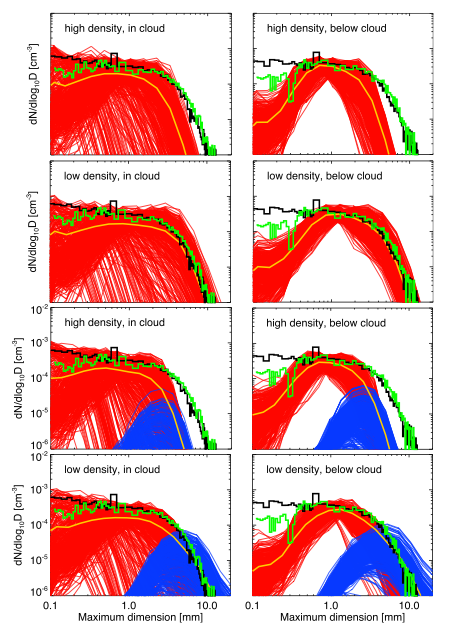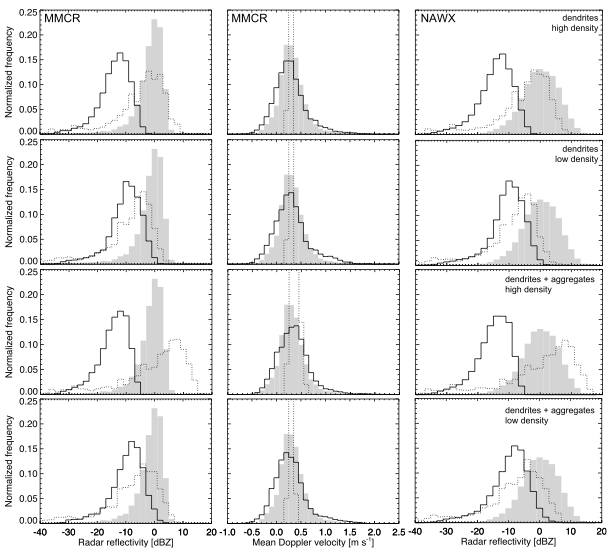Understanding Ice Formation in Arctic Mixed-Phase Boundary-Layer Clouds During ISDAC
Submitter:
Ackerman, Andrew — NASA - Goddard Institute for Space Studies
Fridlind, Ann M. — NASA - Goddard Institute for Space Studies
Area of research:
Cloud Distributions/Characterizations
Journal Reference:
Science
Shallow, persistent cloud layers that contain both liquid droplets and ice crystals are common in the Arctic. With cloud tops warmer than -38 degrees Celsius, ice formation depends on aerosols that preferentially freeze at warm temperatures, referred to as ice nuclei. However, past studies of Arctic mixed-phase clouds have been unable to explain the measured abundance of ice crystals larger than 100 microns in maximum dimension (the size range where measurements are available), given observed environmental conditions and the measured concentrations of ice nuclei that could be entrained into the observed shallow cloud layers from aloft. Several studies were able to roughly reproduce the observed ice distributions, but only by invoking novel mechanisms for ice formation or by including sources of ice nuclei not confirmed by the measurements.
The ISDAC field campaign, deployed from Barrow in April 2008, provided improved observations of two new cases of single-layer, mixed-phase, stratiform clouds that are well-suited to test our understanding of ice formation. This study focuses on the April 8 case (flight 16), when the average ice nucleus concentration measured above the boundary layer substantially exceeded the average ice number concentration within the cloud layer, and the predominant ice habit was dendritic, which is a slow-falling crystal type. Thus, the entrainment source of ice nuclei was relatively large (compared to previous case studies) and the sedimentation sink of ice crystals was small. We used detailed numerical simulations (large-eddy simulations with bin microphysics) to test our understanding of ice formation in this climatologically important cloud type.
Impact
ISDAC flight 16 was flown in a pattern that included spirals over the ARM Climate Research Facility North Slope of Alaska Barrow site, thereby allowing us to use the surface-based millimeter wavelength cloud radar (MMCR) in addition to the airborne X-band radar that flew on the Canadian Convair-580. The aircraft also made in situ measurements of cloud microphysics and ice nuclei, as well as meteorological state parameters and radiative fluxes, which were important study inputs. Because dendrites and their aggregates often reached millimeter sizes for this case, for which a so-called soft-sphere model of radar backscattering is inaccurate, we used the generalized muliparticle Mie method presented in a companion study by Giovanni Botta and co-authors to compute radar reflectivities from our model output. Because of uncertainty in which type of dendrites to specify for the model simulations, we ran two sets of simulations, with high- and low-density dendrites and aggregates.
We found that without crystal aggregation, our simulations using low-density dendrites were able to predominantly match the in situ measurements, but this rough match required either increasing the overlying ice nucleus concentration fourfold or assuming a reservoir of ice nuclei from the surface layer to be entrained from the underlying, decoupled surface layer (both conceivable; see paper for details). However, the simulations without ice aggregation were unable to match the observed radar reflectivities and Doppler velocities. Including aggregation, in addition to quadrupled ice nucleus concentrations aloft or an ice nucleus reservoir below, allowed the simulations to roughly match the in situ properties when assuming the presence of low-density dendrites and their aggregates (Figure 1). Simulations with high- and low-density dendrites and aggregates also bracketed the radar observations (Figure 2), indicating that a mixture of dendrite types could explain the radar observations.
Summary
Explaining ice formation in this cloud type using a well established theory represents a major advance. However, we caution that these results do not imply that the ice formation problem is solved because several unique conditions favored agreement between simulated and observed ice crystal number concentrations in this case: overlying ice nucleus concentrations much greater than in-cloud ice crystal concentrations, very slow-falling ice crystals, and the possible presence of an ice nucleus reservoir below a decoupled surface layer.
We also note that agreement between observed and simulated ice crystal number concentrations in our study required the concentration of entrained ice nuclei to be much greater than the number concentration of ice crystals, which conflicts with studies that indicate that entrained ice nucleus concentrations are equal to in-cloud ice crystal concentrations. The latter would require a negligible sedimentation sink of ice, which is unrealistic even for slowly falling dendrites.
Two shortcomings of this study are that (1) the size-dependent properties of ice crystals are unconstrained by the available measurements and (2) there are no reliable ice water content measurements. Measurements targeting these two gaps would provide a more stringent test of model performance and theoretical understanding.



